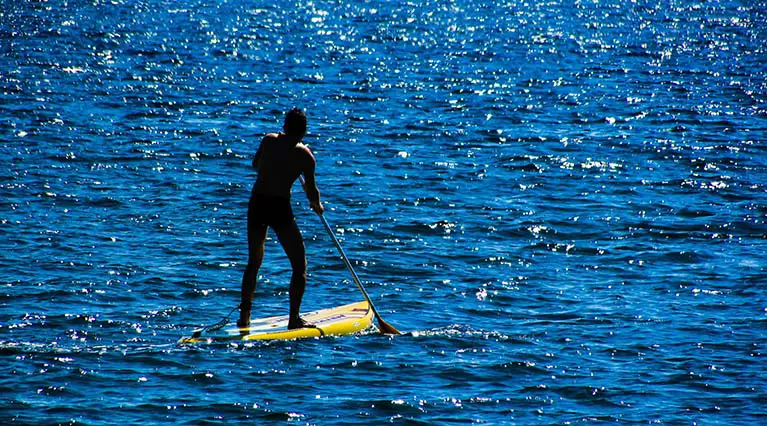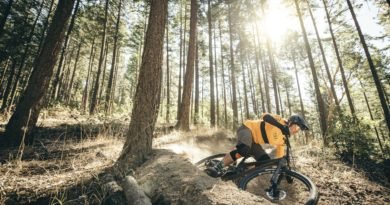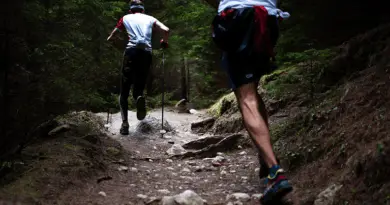Last modified on April 6th, 2020 at 10:45 am
Paddle Boarding Tips For Beginners
Don’t be that guy or that girl. Avoid the most common first-timer mistakes made by people who are new to paddle boarding. This top 10 list is designed to help give paddle boarding beginners a leg up, so they learn to enjoy their newfound hobby.
1. Don’t be afraid to use a leash
This actually goes for all stand-up paddle boarders, but the sooner you realize how critical a leash is to having a positive paddle boarding experience, especially for a beginner, the better.
There are many different types of leashes you can get for your paddle board. Not all paddle boards come with them, so make sure you get one if you don’t have one already. Also, make sure you get comfortable with wearing it. We recommend using them all the time, not just when you are learning.
2. Face your paddle the right way
When you first get on your paddle board, there’s an instinct not to pay much attention to your paddle. However, this can be a mistake that leads to you accidentally belly flopping into the water. The best way to have your paddle is not to have it scooping the water as you try to balance, but rather have it the other way around. This results in less stress and strain being put on your shoulders and elbows. You want the paddle to be pulled through the water, and when the blade is verticle, it provides the best angle and power. Additionally, this is the most stable way to cruise through the water. Less scoop, more smooth pushing and pulling to help you glide through the water.
3. Face the right direction
To non-paddle boarders or regular water-goers, it is not immediately obvious which end is the front/nose of the board. Many beginner boards have large rounded off noses, and a tail section which provides excellent stability. They also have a large deck which provides increased stability.
The best way to make sure you’re paddle board is facing the right direction is to check the location of the fins. They should be toward the tail end when you paddle. The fins at the back aid in keeping the board straight (called tracking), and help you stay firmly on the board while you’re going over potential waves. If you have your fins up front, this can make for an extremely twitchy board which you’re probably going to fall right off of.
4. Paddle with your core – not your arms
This may seem a bit strange, but power and stability for a paddleboarder comes from utilizing their core, rather than their arms to propel themselves across the water. If you focus on using your core muscles rather than your arms, you’ll find that you will become much less winded and be able to balance and cruise more effectively. If you’re standing up tall and using your arms to paddle, you’ll get exhausted within a few minutes. You’ll find yourself working harder but not going very much further.
5. Look at the horizon – don’t get target fixation
Target fixation is something I learned from riding motorcycles, but the same concept applies to paddle boarding. Essentially, it means you go where you look. It can be tempting to look at the water when you first start paddle boarding but guess what that means? Yeah. You’re going into the water. Keep your eyes up and look where you’re trying to go, not at your board and not at the water. I cannot tell you how many times this technique has saved my life on a motorcycle, so I bet it’ll save a few people from falling off their board.
6. Stay out of the way
The ocean is enormous, lakes are big, and the rivers are broad. However, we continually seem to want to use our paddle boards in the same square inch of water! Paddle boards are very large, and they can hurt someone if you run into them. Be mindful of other paddle boarders in the area and make sure to give them ample space. If you stay out of their way, they will stay out of your way, and we will all be happier with our paddle boarding experience.
7. Fall off your board the right way
Even the pros fall off, so this is always going to be a part of your stand up paddle boarding. What is essential though, is how you fall. Just like you can practice tricks and wave riding, practicing falls or at least being aware of how to slip and fall safely can ensure your session is not cut short by injury. Paddleboards are big and can hurt when they hit you when you fall; you want to slip away from your board. Practicing how to fall can mean the difference between laughing it off when the actual time comes that you take a fall, and getting an injury that cuts your day short.
8. Only ride the surf you can handle
This goes for just about any new sports someone picks up. Stay within your skill level, and slowly practice to work your way up to tricker rides. If you are familiar with surfing, paddle boarding should feel second nature. However, if this is an entirely new sport to you, you may want to stick to low-surf areas such as lakes and rivers before you try paddle boarding in the ocean. If you get in over your head with surf that’s too rough, before you know it the water will be over your head too.
9. Watch the wind
This is an extension on #8. You should always be aware of the conditions you are getting into. Know the weather, and keep an eye on how windy the area will be. If you aren’t paddling in the ocean, this is slightly less important but still worth mentioning. Check the weather before you leave and keep an eye on it as much as you can during your day. Especially in coastal areas, the weather can change in the blink of an eye, and you don’t want to get stuck in surf that is bigger than you can handle. This can result in an injury or worse.
10. Look after your board and paddle
Paddleboards for beginners are big. To make them manageable, maneuverable and strong, they need to be built out of lightweight, high tech materials making them expensive. Look after your board and paddle, and they are fragile when thrown around on land. Your board will thank you!
If you’re in the market for a beginner paddle board, read more about them in our post about the best paddle board options for beginners.
I have been a nature enthusiast since I was a small girl. My background is in online marketing and website development. It only makes sense to merge my love for nature with my skills in online marketing to help spread awareness, and appreciation for Our Beautiful Planet.





